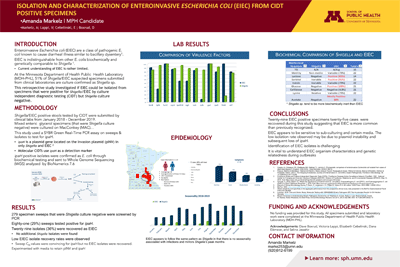Amanda Markelz
MPH, Environmental Health
Co-Authors:
Vicki Lappi, ELizabeth Cebelinski, Dave Boxrud
Advisor:
Dr. Craig Hedberg
Educational Objectives:
- Recognize that EIEC may be more prevalent than previously thought.
- Understand laboratory methods to differentiate EIEC from Shigella.
- Assess stability of the invasion plasmid in EIEC.
Keywords:
Enteroinvasive E. coli (EIEC), Culture Independent Diagnostic Testing (CIDT)
Abstract
Background: Clinical materials positive for Shigella/EIEC by culture-independent diagnostic tests (CIDT) are required to be submitted to the Minnesota Department of Health Public Health Laboratory (MDH-PHL). At the MDH-PHL, 51% of Shigella/EIEC specimens submitted are culture confirmed as Shigella sp. Molecular CIDTs (BioFire FilmArray, Nanosphere Verigene) use ipaH as a detection marker for Shigella/EIEC but these organisms can only be differentiated by biochemical and genetic analysis. This retrospective study investigated whether EIEC could be isolated from specimens positive for Shigella/EIEC by CIDT but Shigella culture negative.
Methods: Shigella/EIEC positive stools submitted from January 2018-December 2019 were cultured on sorbitol MacConkey (SMAC) agar and the representative growth sweep was frozen in glycerol. The frozen glycerol sweeps that were culture negative for Shigella were grown on MAC. The ipaH PCR was performed on mixed colony sweep extracts. Sweeps positive for ipaH were sub-cultured on MAC or tryptic soy blood agar (TSBA) and colony PCR used to identify possible EIEC isolates. PCR positive isolates were screened by biochemicals and confirmed as EIEC.
Results: Two-hundred seventy nine retrospective specimens were screened by PCR and 81 (33%) sweeps tested positive for ipaH. Twenty nine (36%) were confirmed as EIEC. No additional Shigella isolates were found. Two PCR positive isolates were found on TSBA after no positive isolates from MAC, indicating that sub-culturing on TSBA may aid in isolate recovery.
Conclusion: Eighty-one potential EIEC positive specimens were identified during this study suggesting that EIEC is more common than previously recognized. EIEC appears to be sensitive to sub-culturing and certain media which would impact the low isolation rate. The low isolation rate observed may be due to plasmid instability and subsequent loss of ipaH. More investigation is needed to further understand optimal EIEC isolation methods to help determine the impact of EIEC on human illness.
Importance: The understanding of enteroinvasive E. coli (EIEC) as a human pathogen is limited. Molecular Culture-Independent Diagnostic Tests (CIDT) for enteric pathogens typically tests for the ipaH gene, which is found in both Shigella and EIEC. This study sought to investigate Shigella culture negative, ipaH positive specimens to better understand the importance of EIEC. Preliminary findings suggest EIEC may be more prevalent than what is thought. Consequently, it is important to further investigate Shigella culture negative, ipaH positive specimens to better understand the role EIEC may have in illness/public health surveillance.

View Poster (PDF)
